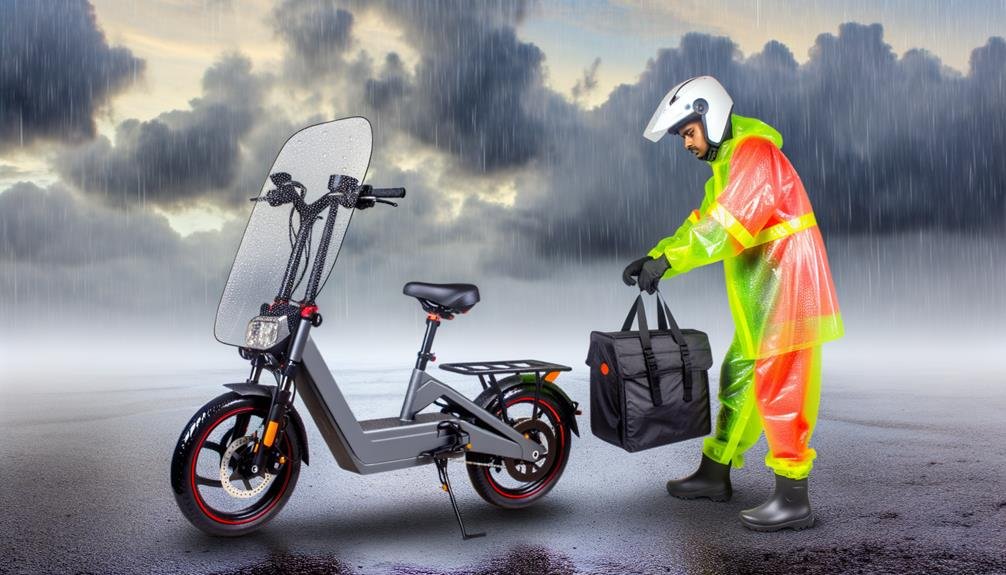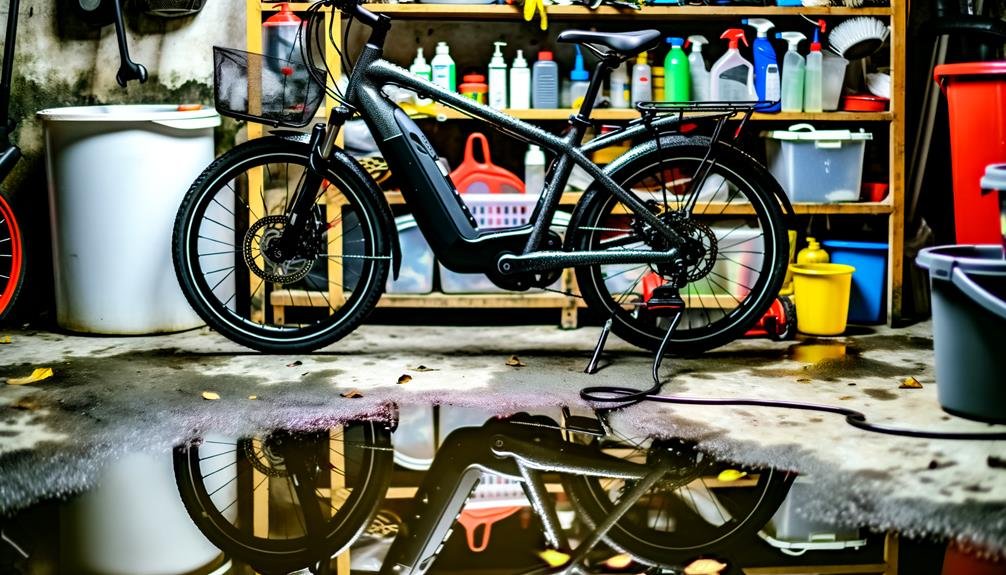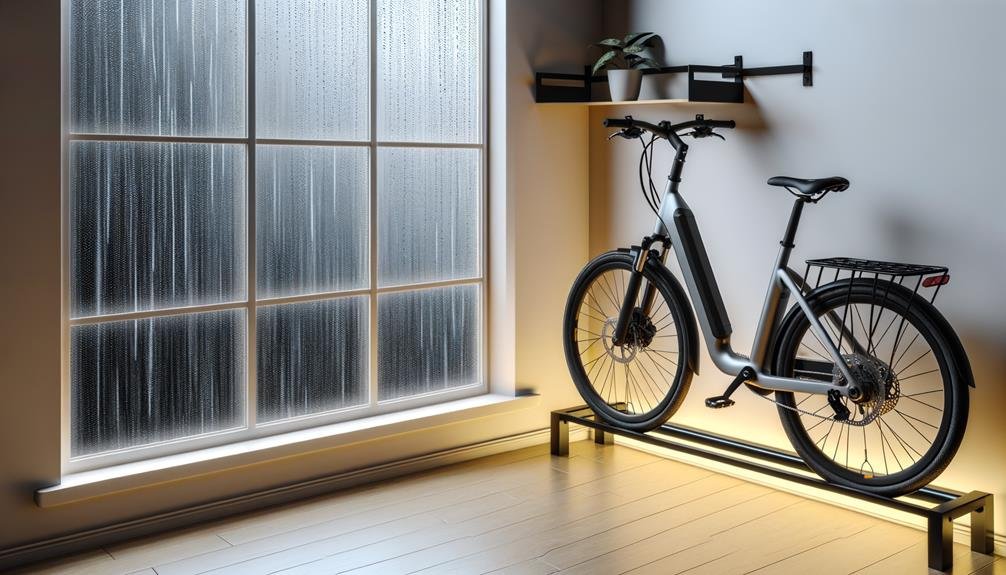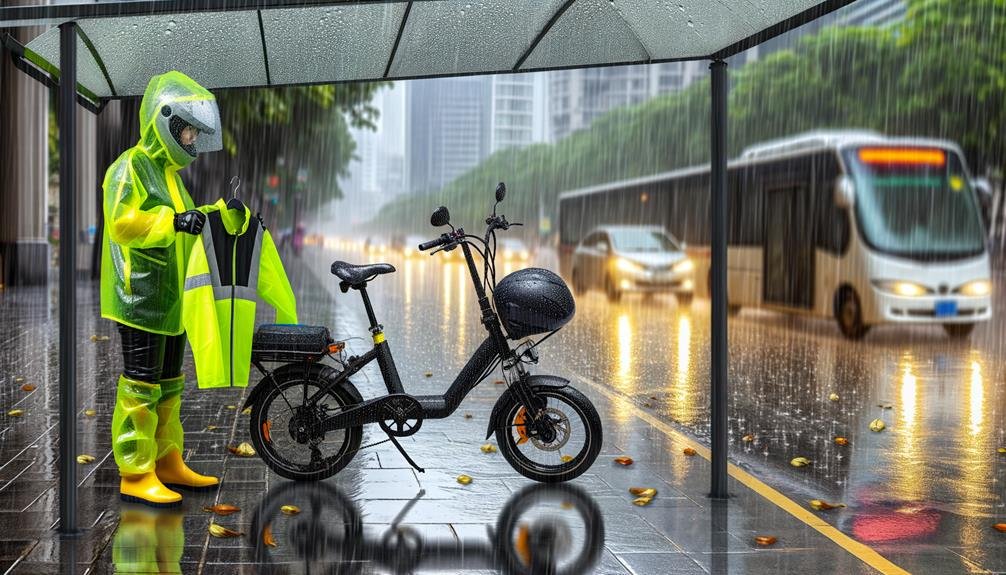Charles Miller is a veteran bike enthusiast with over 12 years of experience dealing with bikes as a mechanic. Despite immense love and expertise for...
As an avid biker, I've often compared my electric bike to the mail carriers of old — 'Neither snow nor rain nor heat nor gloom of night stays these couriers from the swift completion of their appointed rounds.'
But is this comparison truly accurate? Can you, in fact, use electric bikes in the rain?
While the simple answer may be yes, there are many factors to consider, such as the bike's water resistance, potential risks, and necessary precautions.
It's a topic that warrants a deeper exploration, so let's dive right in, shall we?
- Key Takeaways
- Understanding Electric Bike's Water Resistance
- Potential Risks of Rainy Rides
- Essential Gear for Wet Weather
- Precautions While Riding in Rain
- Post-Rain Cleaning and Maintenance
- Protecting the E-bike Battery
- Indoor Storage Solutions
- Dealing With Rain-Induced Damages
- Tips for Safe Wet Weather Travel
- Avoiding Extreme Weather Conditions
- Frequently Asked Questions
- Conclusion
Key Takeaways
- Electric bikes are designed to withstand wet conditions like rain and puddles, but it's important to avoid submerging the bike or blasting it with high pressure.
- After riding in the rain, it's important to wipe away excess moisture, remove the battery for drying, and clean the moving parts. Never submerge the motor or battery to prevent serious damage.
- Wet conditions can lead to safety hazards such as skidding and reduced traction. It's important to ride at a slower speed, brake early and smoothly, and utilize safety gear like lights, high-visibility clothing, and mudguards.
- Regular cleaning and maintenance, including cleaning and re-lubing the chain and drivetrain, is essential to prevent gear issues and damage from moisture. Using covers, battery plates, or pin covers can also help protect the e-bike battery from moisture.
Understanding Electric Bike's Water Resistance
Let's dive into understanding how water-resistant our electric bikes actually are, and how they can handle wet conditions like rain and puddles. Many of us fear that riding in the rain might damage our precious bikes, but you'll be relieved to know that electric bikes are designed to withstand such conditions.
Built with water-resistant features, these bikes can safely be ridden in the rain or through puddles, and even be washed without damaging the electric components. Some bikes even have specific IP ratings, indicating their level of water resistance. The higher the IP rating, the better the bike can handle heavy rain or soaking. But remember, it's still essential to avoid submerging the bike or blasting it with high pressure.
While riding in the rain, it's important to cover any vulnerable areas to protect the delicate electrical components. After your ride, don't forget to wipe away excess moisture, remove the battery for drying, and clean the moving parts. This is key in understanding electric bike's water resistance and ensuring smooth operation.
Even bikes without IP ratings can handle rain to an extent, with proper maintenance and storage practices. So, don't let the rain stop you from enjoying a ride, because we're all in this together.
Potential Risks of Rainy Rides
Let's take a moment to consider the potential risks that come with riding electric bikes in the rain.
One of the primary concerns is the possibility of water damage to the bike's electronic components.
Additionally, the wet conditions can lead to safety hazards such as skidding and reduced traction.
Water Damage Concerns
One major concern when using electric bikes in the rain is the potential for water damage. If you're considering taking your ebike in the rain, you need to be aware of water damage concerns. Now, you shouldn't panic, but you should follow these four simple rules to protect your motor or battery:
- Never submerge your motor or battery. This could lead to serious damage.
- If you have to ride through deep water, turn off the electrics first.
- Don't turn the power back on until your motor and battery have completely dried.
- Always store your ebike in a place where it can't be submerged.
Safety Hazards in Rain
Navigating through the downpour on your electric bike, you must be cognizant of the safety hazards that come with rainy rides. When you ride an Electric Bike, riding in wet conditions can be risky. The dangers of using electric bikes in the rain are real, so it's crucial to be prepared.
Here's a quick guide to your safety:
| Safety Hazards in Rain | Solutions |
|---|---|
| Wet surfaces | Slow down, brake early |
| Deep water | Avoid submerging motor, battery |
| Poor visibility | Use lights, high vis clothing |
| Gear issues | Clean, re-lube chain after ride |
| Water damage | Cover battery, display |
Essential Gear for Wet Weather

When biking in the rain, it's crucial to gear up with waterproof panniers, mudguards, and a helmet with a visor for optimal visibility and protection. These are part of the essential gear you'll need for a safe and hassle-free ride in the rain.
Now, let's answer the question, what's the essential gear for wet weather? Well, here's my advice:
- Waterproof Panniers: Invest in these to keep your valuables dry. Nothing ruins a rainy day ride quicker than soggy belongings.
- Mudguards: These are your best friends. They keep road spray from muddying you and your bike.
- Helmet with Visor: This keeps the rain off your face, maintaining visibility. Clear glasses can also do the trick.
- Lower Tire Pressure: This gives better traction in wet conditions, enhancing stability and control.
Don't forget safety enhancements like lights and high-visibility clothing. They're not just add-ons, they're lifesavers in low visibility situations. This gear not only ensures that you can ride comfortably in the rain but also that you belong out there, with all the other riders who won't let a little wet weather stop them.
Precautions While Riding in Rain
Having prepared ourselves with the essential gear for wet weather, let's now focus on the specific precautions to take while riding in the rain to ensure our safety.
When riding an E-bike, it's important to avoid water that can submerge your motor and battery. This is a key precaution while riding in rain, as it helps prevent damage to your E-bike.
Before you ride through deep water, always turn off the electrics and wait until the motor and battery have dried out before powering up again. Also, remember to ride at a slower speed in the wet, brake early and smoothly. This allows us to anticipate and avoid potential problems on slippery surfaces.
Utilize your safety gear. Lights, high vis clothing, and mudguards not only improve your visibility, they also offer protection from the rain.
After your ride, clean and re-lube your chain and drive train. This will keep your E-bike in top shape and ready for the next ride.
Post-Rain Cleaning and Maintenance

After a good rain ride, it's crucial to take care of your e-bike to ensure its longevity.
We'll first talk about how to properly dry your e-bike post-rain ride.
Then, we'll touch on regular maintenance steps that will help keep your e-bike in top shape, rain or shine.
Drying Your E-Bike
To keep your e-bike in top shape, it's crucial to properly dry and clean it after a rainy ride. Here's a simple 4-step guide to help in drying your e-bike:
- First off, use a towel to wipe off excess moisture from your ebike after riding. This prevents any immediate water damage.
- Secondly, always remember to remove the battery. Let it dry for a few hours before reattaching to prevent any electrical issues.
- Next, pay attention to your chain and drivetrain. Clean and re-lube them to maintain top performance.
- Lastly, consider using a leaf blower to dry hard-to-reach areas.
Regular Maintenance Steps
Now that we've covered how to dry your e-bike, let's move on to regular maintenance steps you should take after riding in the rain.
Cleaning your bike thoroughly is essential to prevent any corrosion and damage. Wipe down every nook and cranny, including the battery contact points.
Don't forget your bike chain—it's crucial to clean and re-lube it to avoid future gear issues.
Protecting the E-bike Battery
When navigating through rain on your e-bike, it's crucial to shield the battery from water, avoiding any submersion of the motor and battery, and never leaving your e-bike to sit in standing water. As part of our e-bike community, you know that protecting the e-bike battery is a top priority when dealing with wet conditions.
Here are four simple steps to follow:
- After riding through deep water, always turn off the electrics and let the motor and battery dry before powering up again.
- Regularly clean and re-lube the chain and drivetrain to prevent gear issues. Keep those battery contact points wiped down with contact cleaner.
- Be especially wary of moisture entering your battery or display when riding in the rain. Consider using covers, battery plates, or pin covers as an extra layer of Ingress Protection.
- Lastly, invest in waterproof panniers and protective bags for your valuables, and don't forget the mudguards for your e-bike.
These practices will help ensure that your e-bike is ready for wet conditions, keeping you safe and your ride enjoyable.
Indoor Storage Solutions

Storing your electric bike indoors isn't just about keeping it out of sight; it's also a surefire way to ward off corrosion and degradation caused by exposure to the elements. It's about taking pride in your ebike, just like you'd a prized possession.
When considering indoor storage solutions, you have a variety of options. You could use a bike cover or storage bag, handy items often found at your local bike shop. These help to shield your ebike from dust and moisture, ensuring the batteries and display remain in pristine condition.
If you're low on space, a bike rack or wall mount can be your best friend. Not only do they save floor space, they also keep your ebike organized and easily accessible.
For those of us with very limited room, foldable electric bikes are a godsend. These can be tucked away in small closets or even under staircases.
Dealing With Rain-Induced Damages
Despite the thrill of riding through a downpour, it's crucial to understand how to protect your electric bike from rain-induced damages. Navigating through rain and mud on your e-bike can be quite an adventure, but it's vital to prepare for the challenges that come with it.
- Avoid Submerging the Motor and Battery: It's best to steer clear of deep puddles when riding your bike. If you can't avoid them, turn off the electrics before entering to prevent damage.
- Use Proper Rain Gear: Equip yourself and your e-bike with fenders, lights, and other rain accessories to ensure visibility and protect the bike.
- Regular Maintenance: Regular cleaning and maintenance of the electrical components are key to dealing with rain-induced damages. This includes re-lubing the chain and wiping down battery contact points.
- Use Protective Covers: Shield your battery and display from moisture with covers, especially during long trips or heavy rain.
Knowing these precautionary measures helps us belong to a community of responsible e-bike users. Remember, our objective isn't just about having fun, but also about prolonging the life of our beloved electric bikes.
Tips for Safe Wet Weather Travel

Navigating wet weather on an electric bike requires some extra precautions. Let's discuss tips on waterproofing your e-bike and other measures for a safe ride in the rain.
We'll also touch on the importance of regular maintenance to secure your bike's longevity.
Waterproofing Electric Bikes
Even though we may try to avoid it, there will be days when we'll need to ride our electric bikes in the rain, so it's crucial to understand how to properly waterproof them for safe and efficient wet weather travel.
Here are some tips for waterproofing electric bikes:
- Familiarize yourself with your e-bike's IP rating. This tells you how well it can resist water and dust.
- Avoid getting your e-bike submerged in water. Especially avoid deep puddles that could reach your motor or battery.
- Invest in waterproof accessories like protective bags for your valuables.
- Regularly clean and maintain your e-bike, especially the chain and drive train.
Rainy Day Precautions
Having waterproofed your e-bike, it's equally important to know how to ride safely and responsibly in the rain. Here are some rainy day precautions.
- First, reduce speed. This gives you extra time to react to sudden changes and avoid accidental contact with obstacles.
- Avoid riding through deep puddles or on slippery surfaces to prevent accidents.
- Use your e-bike's lights and wear visible clothing to ensure you're seen.
- After using electric bikes in the rain, it's crucial to dry them off thoroughly. Wipe away excess moisture and let the system dry by removing the battery for a few hours.
These simple steps will ensure that you can enjoy e-bikes in the rain safely and responsibly.
Avoiding Extreme Weather Conditions
When it comes to tackling extreme weather conditions on your electric bike, it's crucial to avoid riding through deep water that might submerge and damage the motor and battery. You might wonder, can you use electric bikes in the rain? The answer is yes, but you need to be mindful of a few key aspects to stay safe and keep your E-bike in good shape.
- Always ride at slower speeds and brake early and smoothly, especially when you ride an E-bike in wet conditions. Don't lean too much into corners to prevent accidents.
- Make sure you're visible. Use lights, wear high visibility clothing, and install mudguards on your bike. Also, consider waterproof panniers and protective bags for your belongings.
- After your ride, clean and re-lube the chain and drivetrain. Wipe down battery contact points, and use a leaf blower or a dry cloth to disperse water.
- Avoid moisture penetration into the battery or display. Use covers and protect vulnerable areas during heavy rain.
Avoiding extreme weather conditions isn't only about safety, but also about keeping your E-bike performing at its best. We're all in this together, so let's make sure we ride responsibly.
Frequently Asked Questions
Is It OK to Ride an Ebike in the Rain?
Yes, I can ride my e-bike in the rain, but with caution. It's like dancing with nature, embracing the raindrops but being mindful of slippery roads. It's a shared journey, rain, me, and my e-bike.
How Do I Protect My Ebike Battery From Rain?
Sure, I protect my ebike battery from rain by using a cover. A protective bag works too. After a wet ride, I clean and re-lube my chain to avoid damage. Caution's key in wet conditions.
Can Water Damage Electric Bikes?
Yes, water can damage electric bikes if they're not properly cared for. It's crucial to ensure the motor and battery aren't submerged and to regularly clean and maintain your bike, especially after riding in the rain.
Are Electric Bike Batteries Waterproof?
Yes, electric bike batteries are typically waterproof. Like a duck in a pond, they're designed to handle a splash or two. However, it's always best to check your specific model and avoid deep water exposure.
Conclusion
Just like a duck takes to water, your e-bike can handle a sprinkle or two. But remember, it's no submarine. Keep its heart – the motor and battery – above water.
Play it safe, slow down, and watch for slippery paths. After the rain, give it a good clean and dry, and tuck it in a cozy, dry spot.
If rain does strike a blow, don't despair – there are ways to heal the wounds. But when the storm roars, best to stay ashore.

Charles Miller is a veteran bike enthusiast with over 12 years of experience dealing with bikes as a mechanic. Despite immense love and expertise for his Tacoma, he rides his Trek Ebike more. Anytime you meet him, you’ll either hear him talking about Bikes, or writing about all things bikes and cars on this blog.
More Posts


